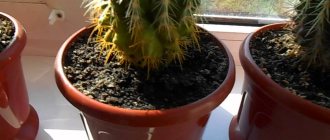Sooner or later, everyone who grows Schlumbergera at home has a desire to propagate this beautiful plant. The most common method of propagation of the Decembrist is vegetative, by cuttings. This method is popular due to its simplicity and high rooting rate.
A cutting is a part of a plant that is used for vegetative propagation. After planting in the substrate, the cutting will develop roots and buds and grow into a new plant. Cuttings for all varieties of Decembrist occur the same way.
Description
This amazing flower is called zygocactus. The plant stands out because it does not go into dormancy in winter, continues to develop and blooms. Reproduction of the Decembrist at home, as well as its cultivation, has a number of features.
The flower, like most cacti, appears in a leafless form. The leaves are considered to be segmented, fleshy thickenings of the stem in which the zygocactus stores moisture. Due to the weight and thin isthmuses between the parts, its shoots bend. Therefore, many gardeners grow this flower as an hanging crop.
The growth and intensity of flowering of zygocactus depends on compliance with these rules. Those who are engaged in flower breeding are interested in how the Decembrist reproduces. There are several ways:
- cuttings;
- leaf;
- vaccination;
- seeds.
Decembrist propagation by cuttings
This is the most common method. The reason for this is its ease and almost 100% guarantee of the desired result. Although this method can be used to propagate a flower at any time of the year, the maximum effect is ensured precisely during the warm period.
The most suitable time for propagation is considered to be from April to May, when the mother plant has completely faded. You need to find a shoot that is not very branched or has a small number of shoots. This will allow you to simultaneously take planting material and force the remaining branch to begin active growth.
For this procedure, you can choose any shoot that has two or three sections. Zygocactus should be carefully examined and healthy and strong parts with aerial roots should be selected. An excellent solution would be to select several cuttings at once, then the flower will turn out beautiful and lush.
It must be borne in mind that experienced flower growers do not recommend taking shoots with piercing and cutting tools. You can ruin the planting material.
The branch that you decide to use for propagation must be taken right at the base, lightly pressed and twisted around its axis until it comes off, remembering to hold the mother plant with your free hand. The procedure for removing the shoot should be performed carefully and carefully, otherwise the flower may be harmed. If suddenly significant damage does occur on the mother plant, it must be covered with soil in which the zygocactus grows. In addition to knowing how to choose the right cuttings, you should study information on how to plant a Decembrist shoot.
There are two ways to prepare cuttings for growth. The essence of the first method is to necessarily dry the shoot before planting. This option is more common and most effective. The cuttings are placed in some container and placed in the place where:
- dry;
- dark;
- chilly.
Basically, planting material is dried for three days. The fact that it is ready for landing is indicated by a thin film formed at the site of the break.
In the second option, the shoot is placed in water. It must be planted when the cuttings have a very branched and strong root system. The root formation period can last up to two weeks. It must be borne in mind that the water in which the cutting is dipped must be taken:
- soft;
- clean;
- without chlorine.
Now you need to familiarize yourself with how to root the Decembrist. In order for the planting of the shoot to be successful, you should listen to the following tips.
For the first time, small glasses are suitable. They must be disinfected and washed well. Place a small layer of drainage material on the bottom, and fill the top with ordinary soil, the basis of which is peat with a slight alkaline reaction. It needs to be watered before planting. Deepen the shoot vertically into the soil up to half its length. It is necessary to organize greenhouse conditions, for which it is necessary to cover it with cellophane or a jar. Place the newly planted plants in a dark place where the temperature is 15-20 0C, not forgetting to ventilate and water regularly. The soil should not be dry and not very wet. As soon as young stems appear, the jar should be removed.
Once the plant has taken root, you need to choose a small pot with more nutritious soil. You can buy it in a special store or prepare it yourself. The best soil consists of:
- six parts of leaf soil;
- four parts of humus;
- two parts of peat and sand;
- one part of turf land.
This type of cactus grows best in soil enriched with peat. Therefore, some gardeners prefer to grow flowers in clean peat. There are two conditions that apply to the substrate - breathability and lightness.
If you follow all the recommendations and carefully monitor the process, flowers on the zygocactus may appear in the same year.
What soil is suitable for planting?
The soil for planting cuttings should be light and loose. You can purchase ready-made soil intended for cacti or universal peat-based soil at a flower shop. also prepare the soil mixture yourself . To do this you need to mix in equal proportions:
- leaf soil;
- turf land;
- peat;
- river sand.
To improve its structure, add perlite and crushed sphagnum moss to the resulting soil mixture.
The main requirement for the soil is that its acidity should not exceed pH 5.0-6.5.
How to propagate using leaves?
Many novice gardeners want to know how to plant Decembrist from a leaf, although this propagation method has been little tested and is not popular. Zygocactus has no leaves; they are replaced by branched and powerful shoots of leaf-like shape hanging down. For propagation, you should take juicy and large parts. Before planting, they are dried for two days. The procedure for preparing the leaf does not differ from that needed for cuttings ripening in the substrate. Before planting, the soil is sprinkled with sand, which is well moistened. The leaf is deepened into the ground with its lower part up to its middle.
Graft
Reproduction of the Decembrist at home by grafting is a rather complicated method. Mostly experienced flower growers resort to it. In this case, the rootstock is spiny pereskia or prickly pear. The upper branched part of the rootstock is removed, the stem is cleared of leaves. Its top is split. For the scion, you can choose a zygocactus shoot consisting of two or three parts. Its lower part needs to be sharpened so that it looks like a wedge, and inserted into the crevice. The graft should be secured with a long spike or needle, secured with a band-aid or adhesive tape. Work must be done carefully and as quickly as possible, while the sections remain fresh. The plant will germinate well at a temperature of 20 degrees and moderate watering. This will take approximately 14 days. As soon as it becomes noticeable that the flower is increasing in size, the fixing bandage should be carefully removed. Zygocactus is grafted in summer or spring.
How to propagate Decembrist at home using seeds? It should be noted that this method is used mainly by breeders to develop new unusual hybrids with delightful colors. However, with this technique, the varietal characteristics of a young plant most often are not preserved.
Selection of capacity
We should not forget that the roots of the Decembrist are superficial, moreover, they are very sensitive to various unfavorable conditions. If they are overcooled or overheated, or the soil becomes acidic, they rot and die. For planting you need a low and fairly wide pot. In a very deep container, the roots do not reach the bottom, so moisture can accumulate below. This waterlogs the substrate and causes rot.
You may be interested in: Violet Humako Inches: description, photo, features of care and propagation
When choosing a pot (if you are replanting an adult plant), the size of the new container can be easily determined by placing it in a new old flowerpot. It should enter completely, and there should be a little free space between the walls (no more than a centimeter). Decembrist can be planted in both ceramic and plastic containers.
Sprout care
The Decembrist flower tolerates propagation at home well. A young seedling needs to be cared for in the same way as an adult. It is necessary to water the plant exclusively with settled warm water. If the air in the room where the newly planted zygocactus is located is too dry, then the shoots need to be sprayed with warm water.
On cuttings with an undeveloped root system, emerging buds should be removed. If all the plant's energy is spent on flowering, there will be no left for the root system. 20 minutes after watering, the water that collects in the pan must be poured out.
Requirements for soil
Since the root system of the Decembrist is quite vulnerable, it does not tolerate stagnation of water in the soil. Therefore, the best choice would be a peat or organic mixture. Light, loose soil has a high throughput capacity, which will protect the plant from some diseases of the root system and reduce the likelihood of damage from pests.
You can prepare the peat mixture yourself or purchase it at a specialty store. To prepare it, you should stock up on coarse sand, peat, charcoal and turf soil. Directly under the soil it is necessary to make a drainage layer that will allow excess moisture not to stagnate. Crushed brick or expanded clay will work as drainage.
You may be interested in: How to grow tulips by March 8: soil preparation, planting and watering features, care
When preparing the soil with your own hands, you should not forget about the need to sterilize it. For this purpose, the mixture can be placed in the freezer for at least 24 hours or steamed in the oven at 200 ° C for 20 minutes.
The only thing the Decembrist will not like in the soil is clay. Therefore, under no circumstances should you add it or loam to the soil for zygocactus. The flower needs good soil capacity, not nutrition.
Rules of care
In order for the reproduction of the Decembrist to bring a positive result, and for the flower to feel good in the house, it is necessary to organize conditions that would be close to natural. This involves creating a warm and humid atmosphere, as well as plenty of sunlight.
If we take into account that zygocactus does not bloom in the warm season, then in spring and summer it can be placed on the windowsills of windows facing east and north. In winter, it is recommended to place the flower pot on the south side. If you don’t turn it at all, the bush will not be symmetrical, since the branches will begin to reach towards the sun. Therefore, flower growers advise moving the plant every month. When growing a flower, it is very important not to disturb it during the budding period. When tying buds, the pot must not be turned or moved to another place. If the Decembrist is moved during the formation of buds, the inflorescences will begin to crumble. Caring for zygocactus is not difficult. The main thing in caring for a plant is to maintain its usual growing conditions.
Peculiarities
Reproduction of Decembrist with the help of shoots allows you to get a new plant while preserving all the species characteristics of the mother bush (flower color). The optimal period for cuttings is the beginning of spring. By this time, Schlumbergera has faded and the growing season begins.
Flower growers note that shoots taken in March take root and grow more actively. If the spring period is missed, then you can take propagation material in the summer, during the formation of the bush.
Information. Decembrist has no thorns, so there is no risk of injuring your fingers when tearing off a cutting.
The number of segments on the process does not matter. Cuttings from 1-2 segments and long shoots taken during molding take root. It is not recommended to take more than four segments; such a process is more difficult to work with. When planting in the ground, installation of supports will be required.
Zygocactus cuttings are rooted in two ways:
- in the substrate (soil for forest cacti, universal soil based on peat, perlite);
- in water.
Both options are used equally. The choice depends on personal preference. If you follow the cutting rules, a positive result is guaranteed both in water and in soil.
How to water?
Excellent propagation of the Decembrist at home is impossible without proper watering, which is the basis for its favorable growth. The watering regime for each stage of zygocactus development is different. During flowering, it especially needs water. Watering should be done regularly so that the soil in the flowerpot is always moist. But the plant cannot be flooded, otherwise the root system will begin to rot, the Decembrist will not bloom and will die. Water the plant with settled water.
This plant blooms from December to February. In order for flowering to be abundant and lush at this time and after, water should be added as the soil dries. Watering should be done as soon as the top layer becomes dry. In spring and autumn, it is extremely important that the soil does not dry out.
Summer is the dormant period for the cactus, when it needs to be watered as the soil dries completely. But in hot weather, the flower must be systematically sprayed. There is another way - a warm shower. To do this, jets of warm water are directed at the leaves of the Decembrist plant, while the ground is covered with film.
Rules for planned transplantation
When is the best time to replant a Decembrist flower? Young plants up to 3 years old need annual replanting. Older zygocacti are replanted only once every 4 years. And if necessary, you can update the top part of the soil mixture.
For a successful result, you should follow the recommendations and step-by-step instructions:
- The pot into which the Decembrist is planned to be transplanted should be slightly larger than the previous one. Its width must exceed its height.
- At the bottom of the container you need to place a drainage layer 2 cm high and a little soil mixture.
- Carefully remove the plant from the old pot, after which, with gentle movements, its roots are freed from excess soil.
- Holding it with your hands, the flower is transferred to a new container, placing it in the center on the soil.
- While continuing to support the zygocactus with your hand, the soil mixture is sprinkled around the root system.
When you have finished replanting the Decembrist, you should not try to compact the soil. It will partially settle on its own after the first watering. Then you will need to add some more soil.
Lighting
This cactus begins to bloom only when daylight hours decrease. The signal for stopping the growth of green mass and the beginning of flower formation is a short daylight hours. If it is still long, then you may not see flowers. Therefore, in winter, the plant absolutely does not need additional lighting.
In summer, exposure to direct sunlight leads to:
- stopping the development and growth of zygocactus;
- yellowing and curling of leaves;
- death of the plant.
Temperature
Decembrist should not be exposed to significant temperature changes. The most comfortable temperature is considered to be +18…+25 0С. In order for the flower to begin to bloom on time, in September - November it is advisable to move it to cooler conditions, where the room temperature is 15 ... + 16 0C. During flowering, it should be brought back to a warm place.
Trimming
This cactus needs to regularly remove excess shoots that appear in the spring. If you do not do this, then in winter it will not be able to please you with its magnificent flowering. Unnecessary shoots should be removed in June. Eliminate those that grow incorrectly and spoil the appearance. You cannot do the work with scissors; you should grab the shoots with your hands and make circular movements to remove excess parts of the flower.
Anyone can cope with Decembrist reproduction. If all the rules of care are properly followed, this variety of cactus will delight you with its beautiful flowers for at least 15 years.











